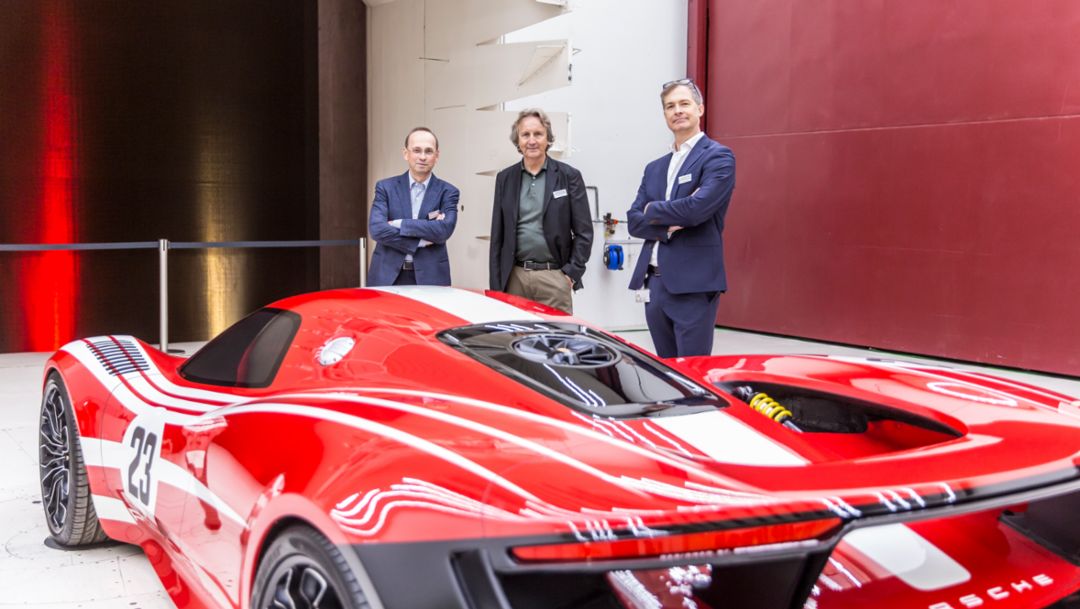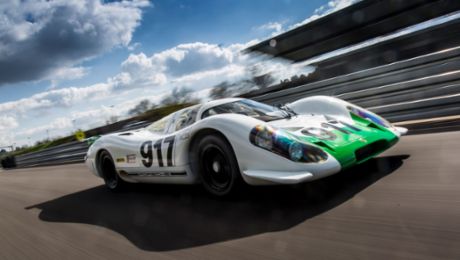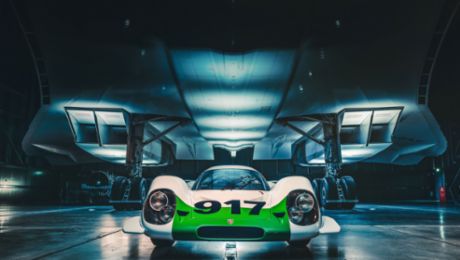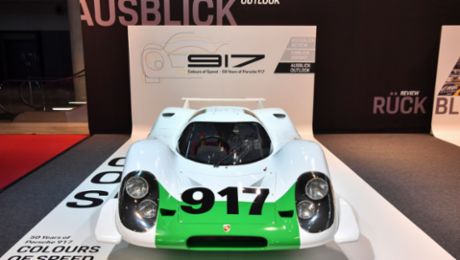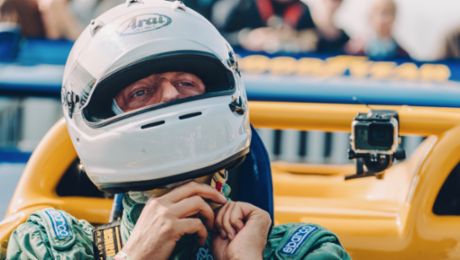It was a grey and cool spring day at the skid pad of the Weissach research and development centre. However, those present were not disturbed by the conditions as they watched the Porsche 917-001 with awe while it completed laps with an incredibly deep engine roar. At the wheel: Le Mans winner Marc Lieb. Those watching on: the makers. For instance Hans Mezger, back then Head of Motorsports and responsible for the project, among other things. Or Hermann Burst, process planner and responsible for the 25 homologation vehicles that were inspected by FIA on the management car park of Plant 1 on 21 April 1969. They were joined by designer Eugen Kolb, body maker Klaus Ziegler, laminate expert Roland Bemsel, test driver Günter Steckkönig and Gerhard Küchle, an engine construction mechanic. And of course Kurt Ahrens – then a works driver without a works contract. A genuine “917 tamer”.
Hans Mezger, Gerhard Küchle, Roland Bemsel, Klaus Ziegler, Günter Steckkönig, Hermann Burst and Eugen Kolb (l-r)
The body
The 917 project was kept secret for a long time – back in the day it was known as the 912. That was not rally an incorrect designation as this was the actual project name of the new V12 engine. The 917’s specifications from 1968 were short and concise: the racing car had to be fast and lightweight to finally be able to claim the overall victory at Le Mans. Consequently, the team developed a tubular space frame weighing a mere 45 kilograms. Eugen Kolb shaped the fibre-glass body over the tubular structure that was produced by Waggonfabrik Rastatt. “Developing the body of the 917 was an innovative task that was new and thus appealing to every design engineer,” he says looking back. “Initially there was significant opposition against the plastic material, something which already started with the 904. And then a private car with a plastic body burnt out because of a faulty fuel pump. As a result, some reported back to Ferry Porsche saying the material was no good. However, he still opted for CFRP.” The body alone increased the vehicle’s rigidity by 50 percent.
Klaus Ziegler, who had not been working in Porsche’s body construction test department for very long, was very sensitive to the atmosphere at the time. “The 917 marked a real leap forward. Not just in terms of displacement and speed. All the technology, Piëch was willing to listen to any suggestion. We went for broke on everything. Today you’d say that the 917 was a technology pioneer.” For instance the engine cover: “Plexiglass was not durable enough,“ he remembers. “A plastic cover deforms as a result of the excessively high temperatures a hot engine generates.” For this reason, developers opted for Plexidur, a solid thermoplastic.
Plastic body maker and laminate expert Roland Bemsel can still remember the problems they had with the windscreens. “Drivers were struggling with reflections. All windscreens were different, as they were shaped by hand. But at least they supported the vehicle’s stability.” However, the main problem was: “Will the body stay on the tubular frame? Is everything secure? We were covering a lot of new territory back then.”
The engine
The greatest attention, however, was devoted to the 4.5-litre V12 engine. Hans Mezger, Head of Motorsports at the time, was responsible for the overall development of the 917 and was the designer for the twelve-cylinder unit, which developed a previously inconceivable output power of 580 PS. He can remember that his department was already working flat out, even without the 917 project. “We nevertheless overcame this challenge – with plenty of flexibility and creativity. Technically 50 prototypes were required for homologation in the five-litre category,” he says, shaking his head in disbelief. “But neither Ferrari nor ourselves would have managed that. And so the requirement was brought down to just 25 units.” Consequently, his department started design work in June 1968 – without having been given the official go-ahead. The greatest issue for Mezger and his team was the lack of time. The engine had to be designed from scratch “and we were not able to adopt many components from other units.” It was already early December when the first engine was running on the test bench.
Gerhard Küchle was as a mechanic in Mezger’s engine construction team, working on the Porsche 908’s eight-cylinder in parallel. He and two to three more colleagues built all 25 917 engines for the homologation types by hand: “It was a major accomplishment, made possible only by giving it our all – and then some. But we also felt like the elite. It was genuinely a great feeling.” At least when sufficient parts were available: “We took our breaks whenever we had to wait for supplies.” Meanwhile, the makers developed wild production methods: for instance, the injection pipes were formed with heat generated by a hair dryer.
Homologation
Hermann Burst was responsible for process planning and homologation – and thus for the construction and functionality of the first 25 917 models. The technical employee and aerodynamics specialist can remember these stressful times well: “The fully assembled vehicle was taken to the wind tunnel of the Research Institute of Automotive Engineering and Vehicle Engines in Stuttgart-Untertürkheim, as Porsche could not yet provide such facilities back then. There it was ensured that the woollen threads were very close to the body.“ In fact, everyone focussed on the drag coefficient. “No-one noticed the fact that the lift values were critical.”
When FIA arrived for homologation on 21 April we had perfectly lined up 25 prototypes using a rope. “It was intended to impress inspectors and it worked,” says Burst, who still remembers this with pleasure. “All vehicles were ready for driving,” he remembers – but what he really means is “ready to roll”. “The FIA inspector chose number 12 and we poured some petrol into the intake funnels.” Number 12 actually started and made it to the plant’s gates and back all by itself. FIA was happy, Burst was happy, Porsche was happy: “By sheer coincidence, the inspector had chosen a vehicle that had all its suspension springs,” Burst admits, “because some of the vehicles were mounted on water pipes as we didn’t have enough springs.”
Testing and racing
The 917 had to be tested as quickly and as much as possible before it was used under real conditions for the first time. Burst can exactly remember those 258 laps on the skid pad, clockwise and anti-clockwise, to test the durability of the wheel bearings. Engineer and test driver Günter Steckkönig was delighted every time he was called to the motorsports department for test drives. Even when he had to take the 917 KH onto the vibration test track: “That was really tough. The 1,000 kilometre endurance run with three to four drivers was also an everyday thing for us.” His most famous visitor in the 917 Weissach racing taxi was star conductor Herbert von Karajan – “and then we swapped seats.” No problem: the musician was a fast and also a good driver. Steckkönig was also at the wheel of the 917 for races: “It rained a lot during the practice sessions at Silverstone. All the water poured into the vehicle – the vehicle was completely open at the bottom in the front. I felt like in a bathtub.” That didn’t stop him from finishing the race in sixth place.
Kurt Ahrens was one of the most important 917 test and racing drivers. He will never forget the shock moment when he was testing the vehicle on VW’s 24-kilometre high-speed track around three weeks prior to Le Mans in 1969 when he crashed into the barriers because the vehicle skidded over a pool of water on slicks. The crash barrier fittings split the racing car into two parts and Ahrens skidded for another 200 metres without a roof over his head and no front section while being strapped into his seat. Nevertheless, Ahrens started in Le Mans in the 917 long tail in 1969 and 1970 – why? “Because it was a Porsche,” he says with a grin. In 1969, he and Jo Siffert even won the 1,000 kilometre race at Zeltweg. It was the 917's very first win. However, the 800-kilogram Porsche was not easy to handle: “The rear of the vehicle was extremely jumpy at 350 km/h and even lifted off if you braked too hard. At 380 km/h I was forced to step off the accelerator a little.”
Legend has it that the wives of the married racing drivers tearfully begged their husbands not to get behind the wheel before the race at Spa. Ahrens recalls: “But the sound was the best part. You could hear all of the work that had gone into the engine.” By the way, the 917 was officially available to purchase – the price tag: 140,000 marks. This included the removable long tail to transform the vehicle into a short tail vehicle, but also the fact that each engine required a top up of four litres of oil for each stint at the Le Mans race. And the flaw that quite a few exhaust parts disappeared into thin air – they just came off as a result of the vibrations.
The 917 Living Legends study
In 2014 Porsche built a design study that, until then, only a few select managers knew about and was never shown to the public: the 917 Living Legends. However, 50 years of the Porsche 917 was reason enough to also present this new interpretation to the heroes from back in the day. Like the archetype, the concept car features a short wheelbase, excellent aerodynamics, a wedge-shaped body and low nose. The monocoque is made of CFRP, the chassis and suspension layout is similar to that of the Porsche 918 featuring deflected, horizontal springs. The makers planned a 750 PS V8 twin turbo engine with PDK transmission as the drive unit. The aerodynamics plays with adaptive splitters, adaptive side sills, a folding air scoop above the engine featuring a fan wheel, wheel arch ventilation and a large, adjustable double-decker rear spoiler with extending Gurney flaps. Some of the details made their way into the series production versions of various on-road vehicles.
The 917-001 in motion
Talking about the road: no-one else but Le Mans winner Marc Lieb is more suitable to bring the restored Porsche 917-001 back to life on the asphalt. The Le Mans winner took to the wheel of a 917 for the first time in 2002, although that was a short tail then. Now he was able to make Number 1 roar, a vehicle that has been so perfectly restored using as much original materials as possible – if front of the delighted vehicle’s makers. They were always involved when the Number 1 was being transformed from short tail to long tail because they are the only ones who are still familiar with certain technical details, dimensions and special characteristics and who were able to help with reproduction of certain parts and body shapes. For no other authentic long-tail vehicle exists in the world for comparison.
“I would be keen to drive the vehicle in racing conditions,” Lieb says, “with plenty of respect – not at full pace and always ready to back off.” He drives number 001 around the test track with the elegance of a perfect racing driver: “The vehicle is very responsive to the accelerator and drives like a normal car,” the professional adds. “Just the brakes are a challenge.”
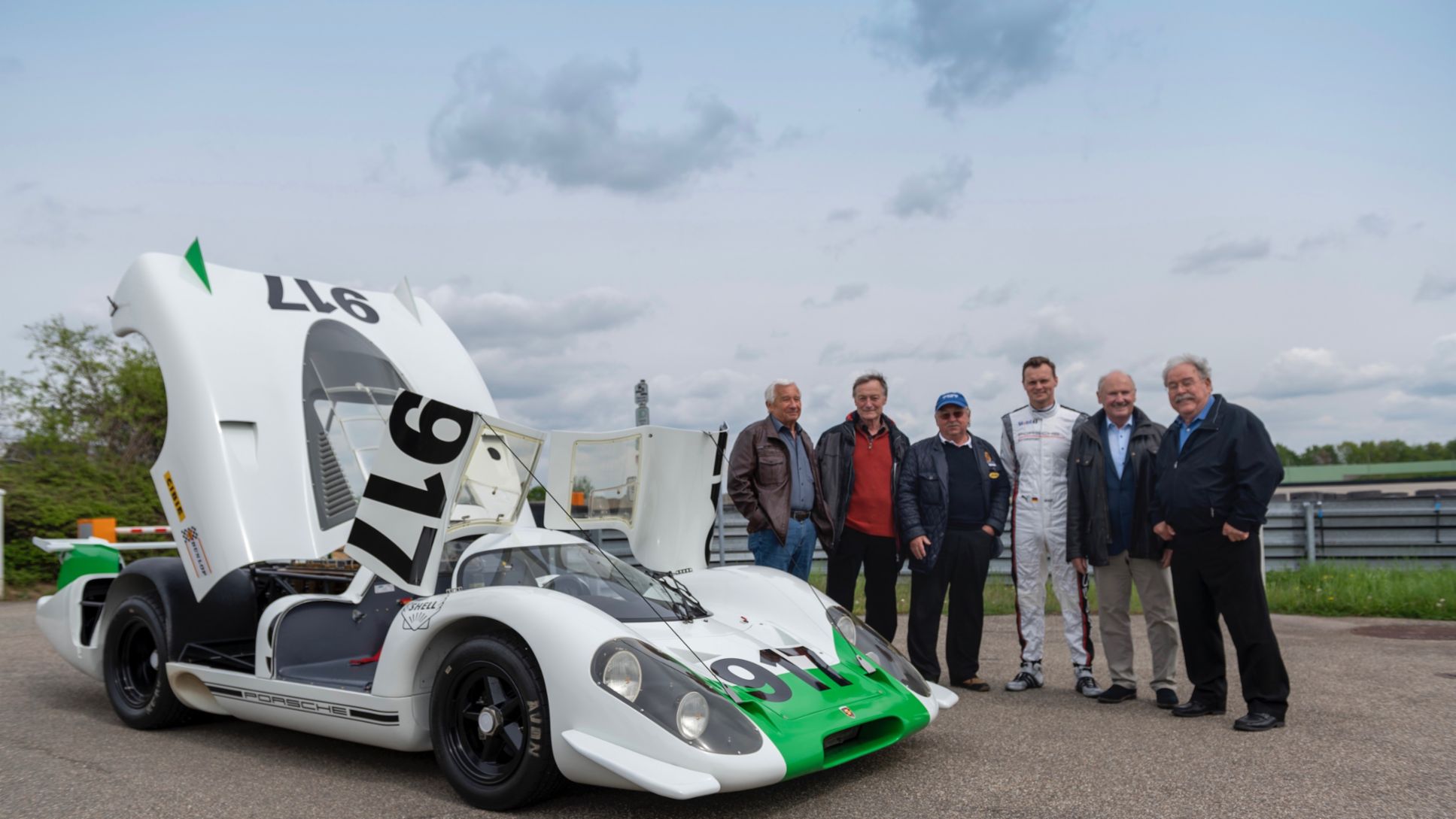

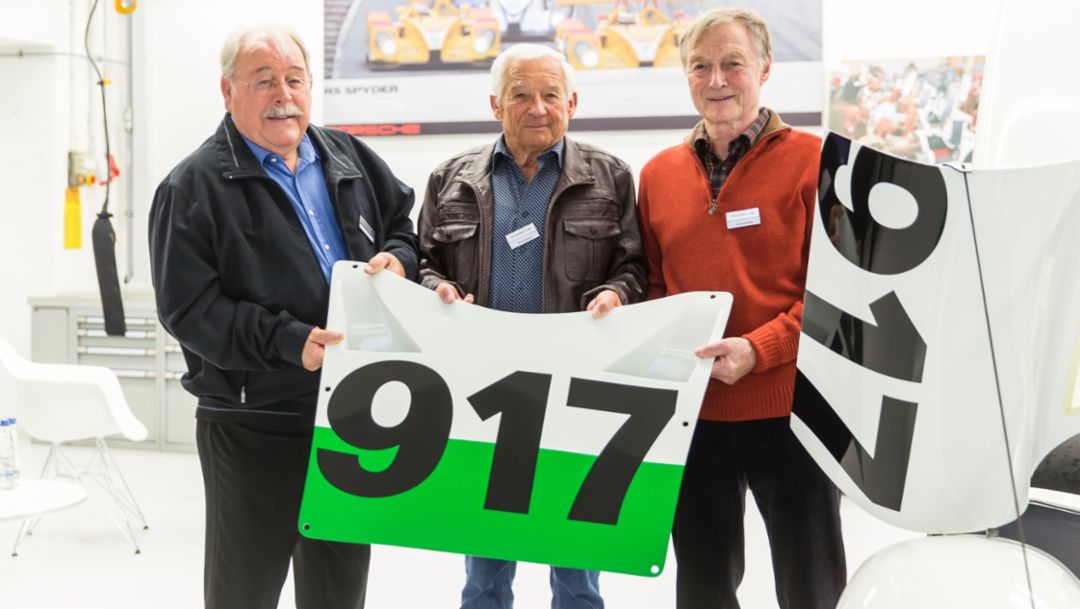
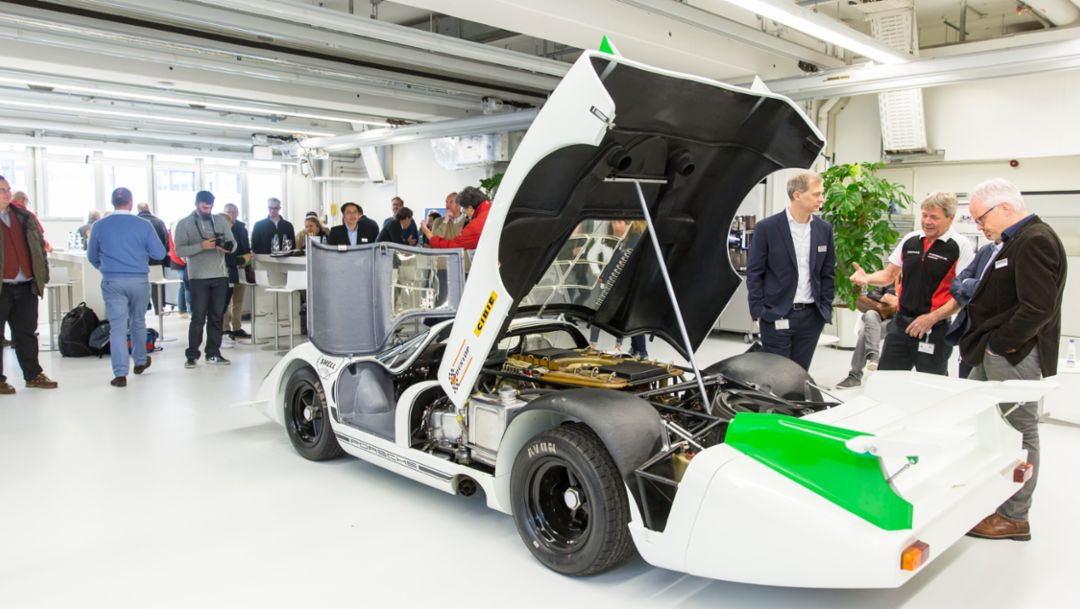
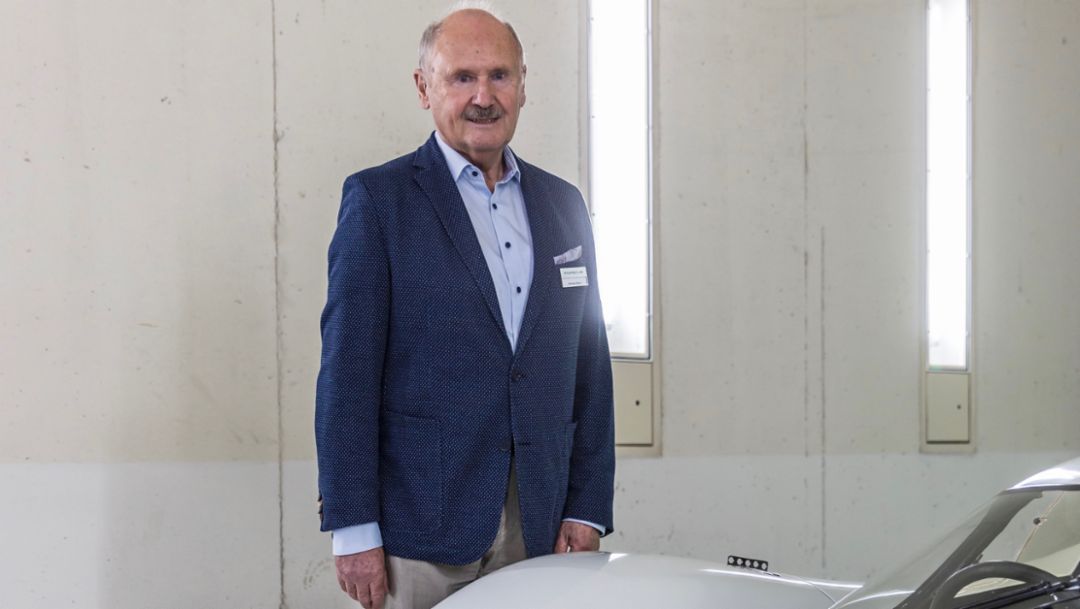
-und-Marc-Lieb.jpg/jcr:content/b-Kurt%20Ahrens%20(links)%20und%20Marc%20Lieb.jpg)
